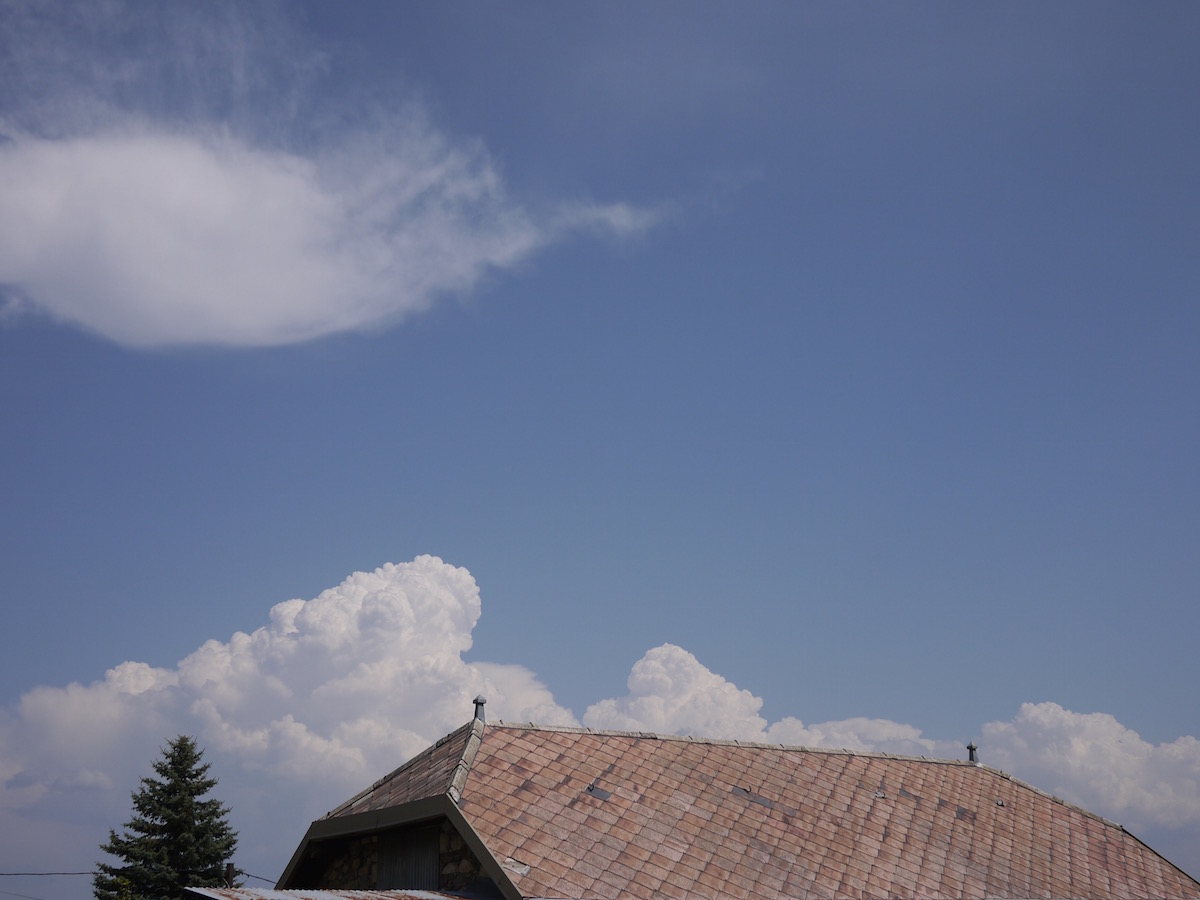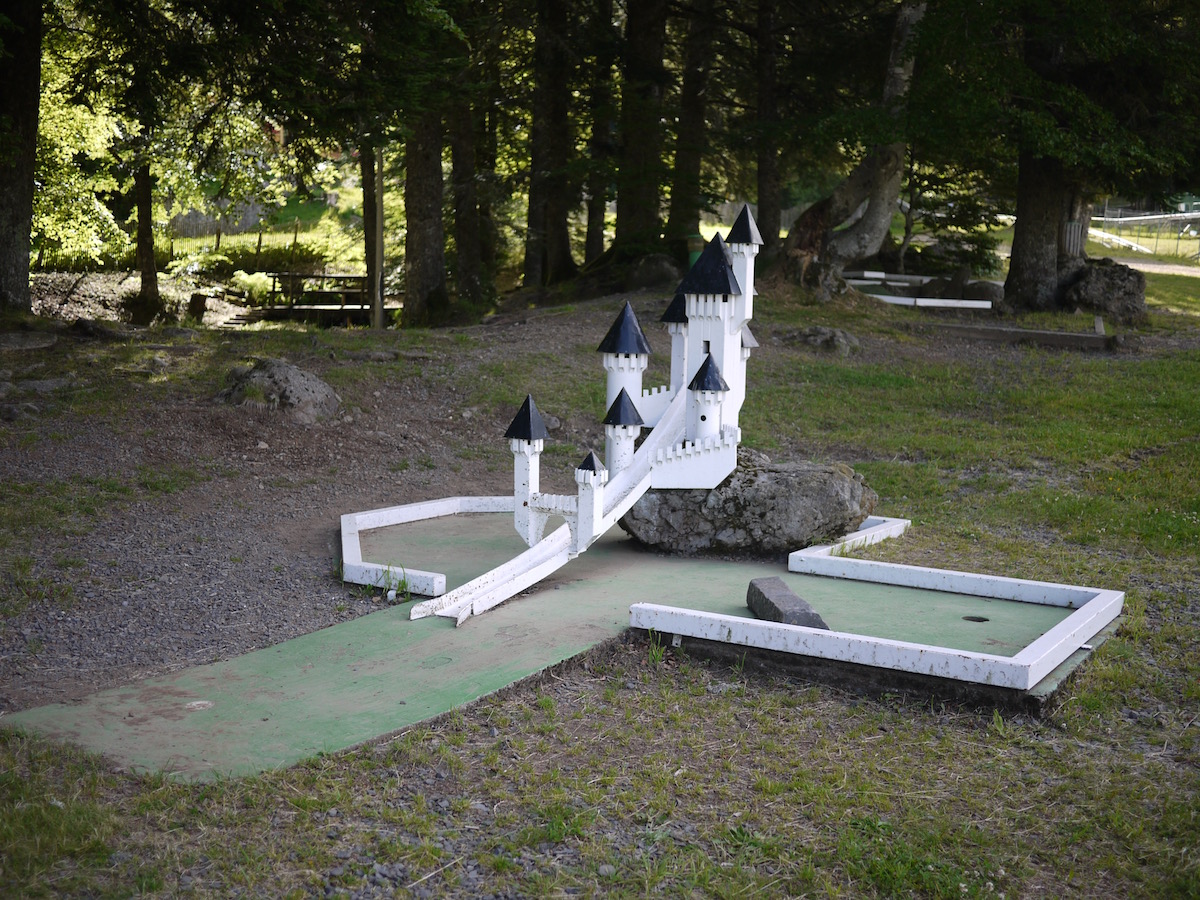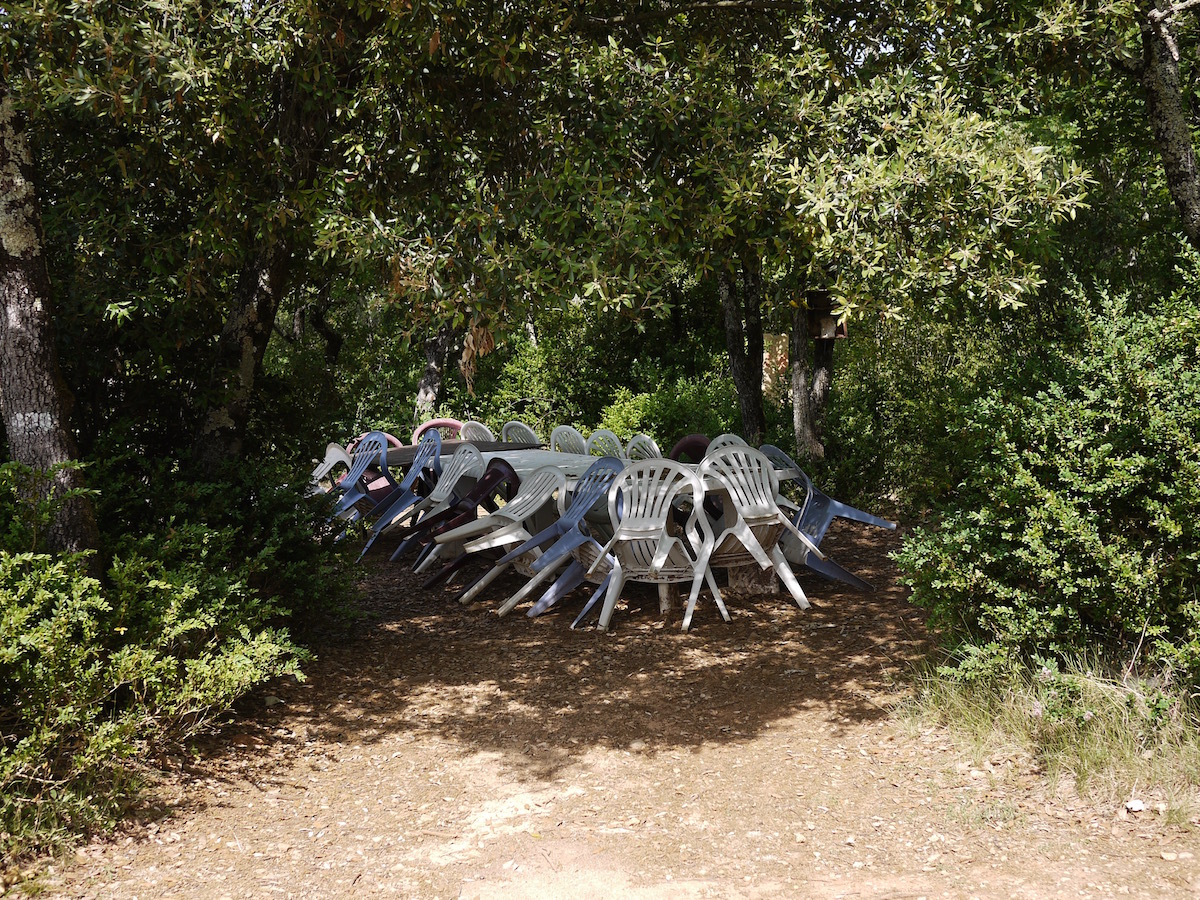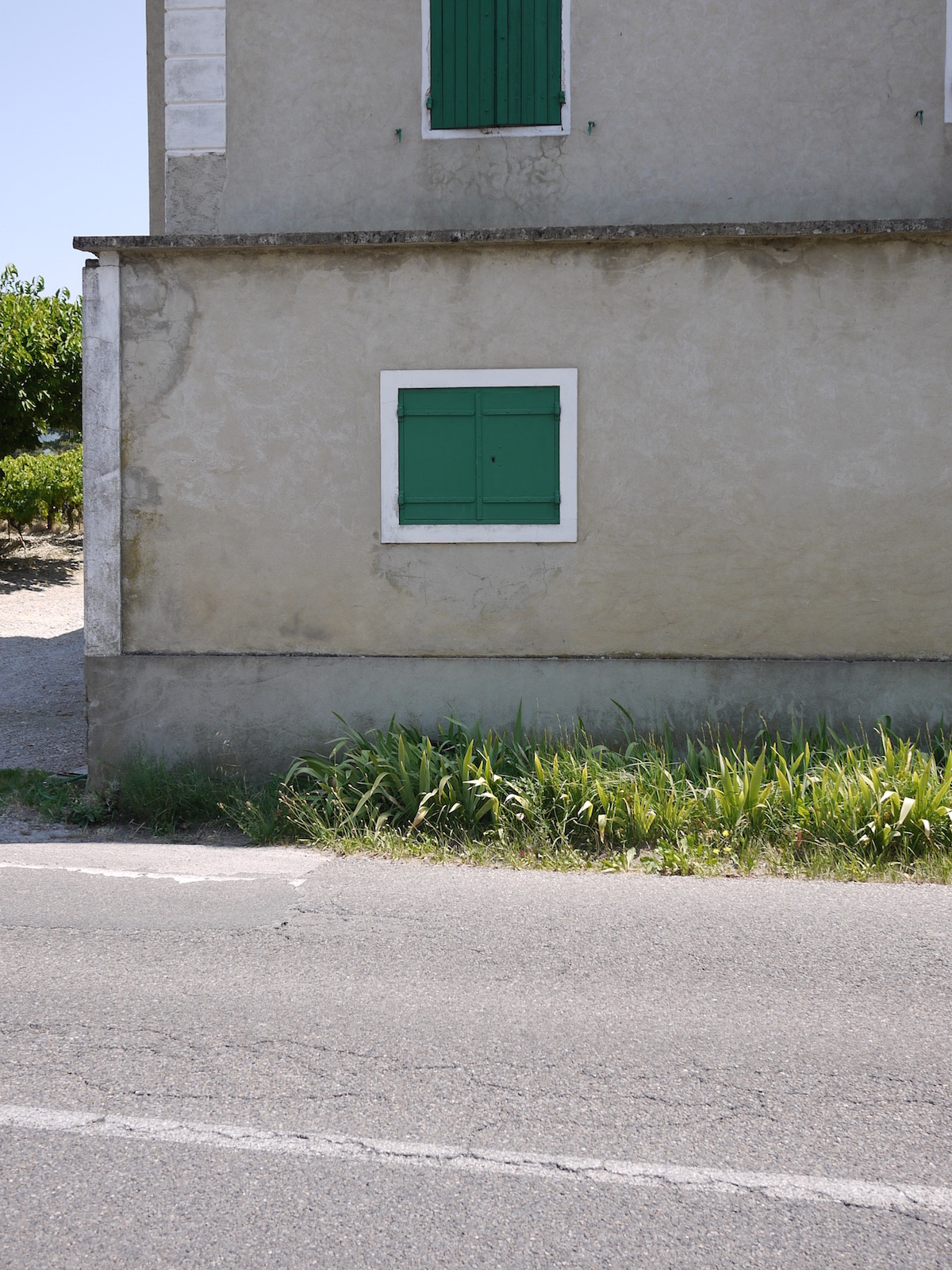Nauzenac and Ubaye were two French villages that were submerged by the artificial lakes created by water dams in the Dordogne Valley, and in the Alps of Haute Provence. From Nauzenac to Ubaye is a 611km walking performance project between the two submerged villages while listening to Armelle Faure’s oral archive The Dordogne River and Dams Project: 100 Witnesses Speak (Armelle Faure 2011-2015).
On June 13th 2015, I left the site of Nauzenac in the upper Dordogne valley with a heavy backpack and an Mp3 device, heading southeast to the site of Ubaye in the Alps of Haute Provence, where I arrived on July 22nd 2015.
The oral archives The Dordogne River and Dams Project: 100 Witnesses Speak (Faure 2011-2015) were created by French anthropologist Armelle Faure, with the support of the French Electricity Group (EDF), in collaboration with the departmental archivists of Cantal and Corrèze. After a career as a World Bank consultant, reporting on the social impact of great development projects in Asia and Africa, French anthropologist Armelle Faure returned to her country to find out how communities of the Higher Dordogne Valley, displaced between the 1940’s and 1980’s had been neglected and forgotten by local authorities and cultural institutions. In 2011, following the 60th anniversary of the Bort-les-Orgues dam, Faure initiated an oral archive aiming to recover the fading memory of the Dordogne valley where five water dams were built between 1932 and 1957, submerging villages, hamlets and farms, and displacing a total of 120 families (approximately 500 persons). During the four years of interviews, between 2011 and 2015, Faure has provoked encounters, discussions, and meetings with living witnesses that often became occasions for reunions with improvised music sessions and songs about the lost territories of the valley. The Dordogne River and Dams Project: 100 Witnesses Speak (Faure 2011-2015) were meant to revalorize the damming of the Higher Dordogne valley from the point of view of the remaining living witnesses. Among the 100 witnesses, we can hear members of the displaced community of Nauzenac, their descendants, persons who lived from the valley’s resources, dam engineers, builders, and also members of the French Resistance. A whole slice of history and other stories that seemed to have vanished under the waters of the great dams gradually resurface at the pace of the discussions.
The choice of Nauzenac and Ubaye was not fortuitous. Nauzenac and Ubaye were both affected by Development-forced Displacement and Resettlement (DFDR). Once the villages had been wiped off the map and the communities dispersed, both displaced communities required a piece of land by the shores of the water reservoirs as close as possible to their submerged village in order to reunite and congregate in memory of their disappeared village. Both communities were granted such sites by their local authorities, namely the site of Nauzenac, where a small outdoor chapel was built, and the site of Ubaye, where a small shed was also built to host festivities. Nauzenac and Ubaye also had the same patroness Saint: Mary Magdalene. And a chapel dedicated to the saint existed in both villages. Before the submersion of the villages, the saint was commemorated every year on July 22nd in Nauzenac and Ubaye, usually with a procession and mass followed by a festive gathering.
The triggering element of the walking performance was to realize that ever since the submersion of their villages, both displaced communities of Nauzenac and Ubaye have continued to congregate every year, each on their respective sites around the 22nd of July, and that this coincidence was unknown to either community. The descendants of Nauzenac celebrate the memory of their elders with a religious mass, involving a procession of the statue of the saint followed by an informal picnic. The elders of Ubaye celebrate with a feast. They bring tables and chairs, accordions and loudspeakers. They set a buffet inside the small shed where photographs of past festivities are displayed. They eat and drink, sing and dance together. Both communities spend a day on a portion of land on the shores of the water reservoir to commemorate the memory of their submerged village. With these yearly congregations, the displaced communities of Nauzenac and Ubaye become communities again. This state of becoming is precisely what made me decide to walk from Nauzenac to Ubaye. The arrival date was set on July 22nd in order to attend the yearly congregation of the displaced community of Ubaye.
Since its very inception, From Nauzenac to Ubaye was conceived and conceptualized as a walking performance. It was designed to open other possibilities and directions to the movement initiated by Armelle Faure’s oral archives.
Two months before the walk, I sent 300 invitation cards by post to people I knew from the Dordogne valley and Serre Ponçon, as well as to academics, colleagues, artists and friends to whom I proposed to walk with me. The invitation cards showed a series of maps with the trajectory from Nauzenac to Ubaye. It also comprised a leaflet with a description of the project, a list of mileages planned for each day, names of each of the walking stages, and a URL link to follow the project on the blog www.nauzenacubaye.wordpress.com. Advertising and announcing the artistic intent of the walk From Nauzenac to Ubaye was a way to formalize the project as a performance. Inviting people to walk with me was an attempt to set off a participatory performance.
On June 13th 2015, at least thirty persons gathered on the site of Nauzenac to attend the departure of the walk and accompany me on the first eight kilometers. Some of the persons who were present were born in the valley; a few had even participated in the oral archive. Everyone seemed excited – some people were curious and others dubious about the long walk I was about to begin while listening to recorded voices recalling the damming and submersion of the Dordogne valley.
After a group picture and a short speech, it was time to go. I plugged in my headphones and pressed play. The first audio file was Françoise Monange singing a cappella. This is a song about the myth of Mary Magdalene. As I listened to the trembling voice of Françoise, my mind entered the memory of Nauzenac. What I saw, what I felt and what I heard connected the here now with the then there. And for the first time, I felt the incredible power of walking here now while listening to this oral archive recorded then there telling stories about hundreds of ‘thens theres’. Walking in the company of this crowd on the day of the departure was energizing and uplifting. It also propelled the walk to the status of a participatory performance.
After that day, I walked on my own for 17 days, until I reached Langogne with a painful Achilles tendonitis on the left foot, obliging me to rest for a few days in Loubaresse. From June 30th until July 22nd a friend walked with me. Together, we walked from Langogne to St-Vincent- les-Forts in Serre Ponçon. On July 19th another friend joined us for 48 hours. Together, we walked from Gap and Espinasses in Serre Ponçon. On the last day of the walk, a group of friends and local people also joined in for the last kilometers. The mayor of St-Vincent-les-Forts and the president of the association Ubaye d’hier et d’Aujourd’hui were present to witness our arrival.
I remained in Serre Ponçon in order to attend the yearly festivities of the displaced community of Ubaye who welcomed me to share their feast, to recount the narrative of my journey from Nauzenac to Ubaye and to celebrate the memory of their lost village. I was proud to be asked to join the 2015 group picture of the Ubaye elders.
In order to connect the dots between the communities of Nauzenac and Ubaye, I arrived with a basket filled with paper rolls to be handed out. These rolls contained excerpts from the oral archives that I had selected and transcribed during the journey. At least 100 persons were present that day. After the formal speeches of the local representatives, the president of the association Ubaye d’Hier et d’aujourd’hui Mr. René Derbez handed me the microphone. As I recounted my experience, my friend who had accompanied me on the walk since the 30th of June, distributed the paper rolls. With this performed finale, the walking performance From Nauzenac to Ubaye was definitively inscribed in a dramaturgy of embodiment, displacement and transmission.
From the perspective of performance and scenography, I propose to break down ‘The Dordogne River and Dams Project: 100 Witnesses Speak’ (Armelle Faure 2011-2015) into as many as a 100 performative processes that actively avoid regressive nostalgia, and re-evaluate place as an ever-changing topographical, social and cultural reality. As the creator of this oral archive, Armelle Faure performs 100 interviews in which she clearly activates the witnesses’ memory, excite their creativity and possibly set off a healing process. ‘It is by speaking that things come back’ says one of the witnesses, or, ‘it feels good to renew all this’ says another one. (Armelle Faure 2011-2015) Bit by bit, Faure retraces the transformation of a territory with the help of photographs, old maps, official documents and other suggestive tools that gradually and actively enable the witnesses to recreate the Dordogne Valley. Performance studies scholar Diana Taylor (Taylor 2003) makes a distinction between the archive and the repertoire. The archive consists of documents such as maps, texts, letters, photographs, and all those items supposedly resistant to change. On the other hand, the repertoire:
Enacts embodied memory: performances, gestures, orality, movement, dance, singing – in short, all those acts usually thought of as ephemeral, non reproducible knowledge. (…) The repertoire requires presence: people participate in the production and reproduction of knowledge by “being there,” being a part of the transmission. (…) The repertoire both keeps and transforms choreographies of meaning.(Taylor 2003: 20)
With the oral archives, Faure provoked encounters and discussions that ‘allow[ed] for alternative perspectives and invite[d] re-mappings’. (Taylor 2003: 20) Once they had been recorded, the interviews became in their turn an archive. If the recordings became an archive, what they represent is still the repertoire. As I listened to Armelle Faure’s oral archives, I heard the repertoire. Therefore, the interviews are not equal; some are long, others are extremely short. Some are extremely informative with precise descriptions of places, persons and happenings. Some witnesses fail to remember; others don’t want to tell. Sometimes, I sensed delicate moments of intense emotions. For Instance, recounting the expropriations is always painful. Sometimes, I could hear the witness sobbing. There are also surprising moments when a witness suddenly recalls what he or she considered a lost memory. Memory becomes a sensorial territory on which the witness seems able to walk. And, just as in a palace of memory, walking through these places unlocks unexpected memories that seemed forever lost.
As a geoscenographer, I intentionally conceptualized this performance as a shifting line of flight emerging from the multiple milieus traversed from Nauzenac to Ubaye. The movement From Nauzenac to Ubaye is also meant to express the idea of a territory in perpetual transformation. The Dordogne Valley from which I departed, and all the places along the trajectory from Nauzenac to Ubaye, were meant not as mere backdrop scenery for a walk but rather as living entities where all elements – human and otherwise / past, present and future – were alive. As the walking body traversed landscapes listening to the stories of the displaced, I was able to experience how ‘performance remains’ (Schneider 2011) and how ‘the place of residue is arguably flesh in a network of body-to-body transmission of affect and enactment – evidence, across generations, of impact’ (ibid.). It was through the flesh that memories, mine and theirs, surfaced as one single experience. Here my body became the archive and the host to a collective memory that would always remain incomplete.
As a way of leaving the end open, I hereby invite the reader into an imaginary landscape of the memory of the Dordogne valley. After recounting the walking performance project, the concluding act of the present paper is to display some of the 81 testimonies / images that were part of the solo exhibition that opened in September 2017 in the exhibition room of the Bort-les-Orgues dam, in the Dordogne valley.
These 81 testimonies / images are here presented as walking snapshots. The photographs were taken between Nauzenac and Ubaye. The texts are excerpts of The Dordogne River and Dams Project: 100 Witnesses Speak (Faure 2011-2015) in French with an English translation. As I listened to the 52 hours of testimonials over the 611km between Nauzenac and Ubaye, I felt body, mind, memory and territory intersecting. As I listened to the witnesses’s descriptions of their deteritorialized landscapes, I was also reterritorializing the land I was walking through by projecting the witnesses’ memories onto it. But mostly, I felt that the land around me belonged to me as much as I belonged to it. There was no hierarchy, just living entities intermingling. Rebecca Solnit describes this feeling very well when she writes:
Walking, ideally, is a state in which the mind, the body, and the world are aligned, as though they were three characters finally in conversation together, three notes suddenly making a chord.(Solnit 2001)
Listening to the oral archives added another dimension to the walk. The voices of the others and their memory provoked confusions between what I listened to, what I saw, what I experienced and what I myself remembered. As the witnesses recalled their homes, their gardens, or their deceased, I unconsciously looked for evidence of these elements in the environing landscape. Everything was tangled. A doorbell rang. I turned around to confirm that I was in a forest. Sometimes I also had strange feelings such as stepping on voices, or dancing to the rhythms of speech, or entering demolished houses, or walking across submerged fields. These stories made me walk across landscapes that were not those I was actually in.
Part of the 81 testimonies / images revealed here are not meant to illustrate the witnesses’ statements but to open another dimension and perpetuate the experience of walking while listening to The Dordogne River and Dams Project from Nauzenac to Ubaye on ‘roads [that] make it possible to trace the route of the absent’ (Solnit 2001: 5).

J’étais adolescente lorsque j’ai commencé à entendre parler d’un barrage dont les eaux allaient engloutir la vallée de Bort à Port-Dieu.
-
I was a teenager when I started hearing about a dam whose waters would submerge the valley from Bort to Port-Dieu.
Odile Bonhomme née Rivière

Notre maison [...] Je me rappelle, ils ont mis un gros câble autour de la maison, ils ont appelé deux bulldozers. Ils ont coupé la maison. Avec un câble et deux bulldozers. Plop. Tombée. C’était cette maison là.Our house […]
-
I remember, they put a big cable around the house. They called two bulldozers. They cut the house. With a cable and two bulldozers. Plop. It fell. It was that house there.
Jean-Claude Legros

Il y en a un qui ne voulait pas partir. Il était monté sur le toit de sa maison. Il a attendu que l’eau lui baigne les fesses pour qu’il ressorte en bateau. Il ne voulait pas partir de chez lui.
-
There was one who didn’t want to leave. He climbed onto the roof of his house. He waited until the water started to bathe his bum before he left by boat. He didn’t want to leave his home.
André and Jean Charrière

Ne me demandez pas une topographie exacte, c’est une topographie sentimentale, si je puis dire, plutôt du cœur. [...] Le château était sur un piton ainsi que la chapelle et ensuite on descendait vers le parc comme on descendait vers la ferme.
-
Do not ask me for an exact topography, as it is a sentimental topography, if I can say that, more from the heart. […] The castle was standing on a spur and so was the chapel. Then we would go down to the park and the farm.
Patrick Hénault

Ce qu’on a emmené. Nos meubles et c’est tout. Nos meubles et nos défunts.
-
What we took with us. Our furniture and that’s all. Our furniture and our dead.
Raymonde Mangane née Grégoire

Une amie intime de ma mère [...] lui a dit: «Écoutes, surtout ne t’expatries pas, ne t’expatrie pas».
-
An intimate fried of my mothers […] told her: ‘Listen, whatever you do, do not expatriate yourself, do not expatriate yourself’.
Yves Juillard
Bibliography
Faure, Armelle (2015), The Dordogne River and Dams Project: 100 Witnesses Speak (2011-2015) (ethnographic oral archives Archives départementales de Corrèze; archives départementales du Cantal, 2011-2015).
Faure, Armelle (2014), 'Déplacements de populations et construction de grands barrages', Centraliens (631), 46.
Schneider, Rebecca (2011), Performing remains : art and war in times of theatrical reenactment (London: Routledge).
Solnit, Rebecca (2001), Wanderlust: a history of walking (London: Verso) 328 p.
Taylor, Diana (2003), The archive and the repertoire : cultural memory and performance in the Americas (Durham, N.C. ; London: Duke University Press).
***
CAROLINA E. SANTO is a theatre designer and a scenographer. Her works include scenography installations, stage and costume designs for theatre and opera productions in Portugal, France, and Switzerland. In 2009 she completed a Master’s degree in scenography at the Zurich University of the Arts (ZHdK) with a grant from the Gulbenkian Foundation. In 2018, she completed her PhD at the University of Vienna with a grant from the Portuguese Science and Technology Foundation (FCT). Her current research considers territory as a potentially expressive performative process. She uses walking as a creative process and proposes to consider geoscenography as a form of scenography from the milieu.

